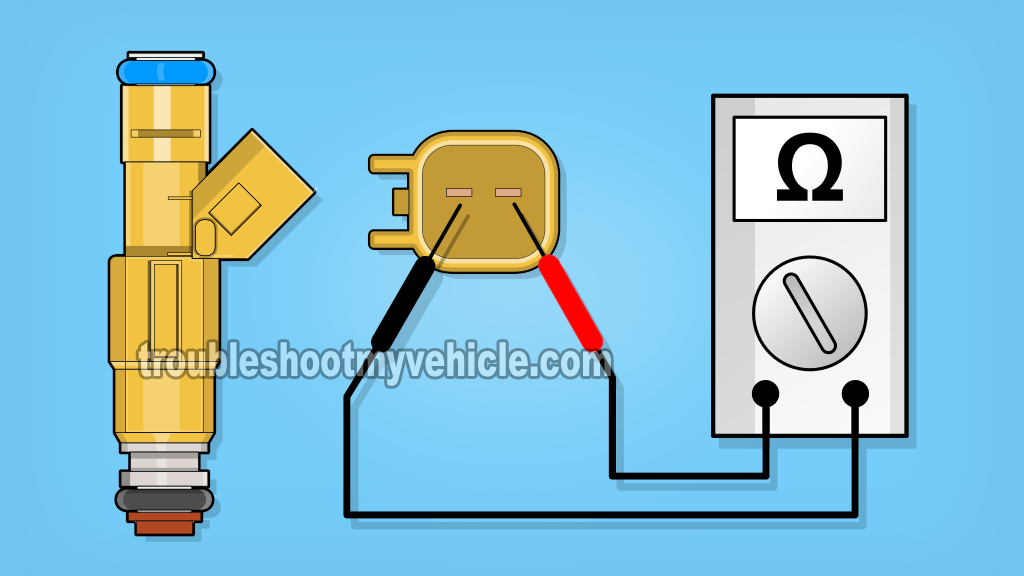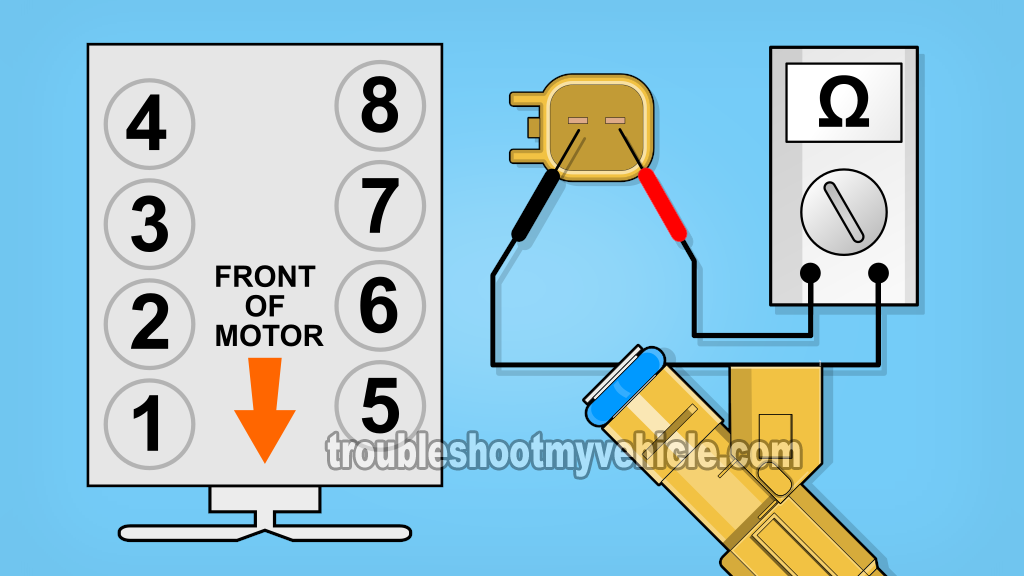
It's not that difficult to test the fuel injectors on your 1999-2000 4.6L Crown Victoria or Grand Marquis to see if any have failed.
In this tutorial, I'll explain how to use a multimeter to perform a resistance test and a fuel injector cleaner tool kit to determine if a fuel injector is good or bad. By the way, no need for an expensive diagnostic scan tool to test them!
Contents of this tutorial:
- Symptoms Of A Bad Fuel Injector.
- Where To Buy The Fuel Injector And Save.
- What Tools Do I Need To Test The Fuel Injectors?
- The Strategy: How To Find The Bad Or Clogged Fuel Injector.
- PART 1: Checking The Injector's Internal Resistance.
- PART 2: Checking The Fuel Injector Spray Pattern.
- Important Tips For Installing A Fuel Injector.
- More 4.6L Crown Vic And Grand Marquis Tutorials.
APPLIES TO: This tutorial applies to the following vehicles:
- 4.6L Ford Crown Victoria: 1999, 2000.
- 4.6L Mercury Grand Marquis: 1999, 2000.
Wiring Diagram: The following fuel injector circuit wiring diagram is available to further help you:
NOTE: The following tutorials may be of help to test the fuel injectors on the 1992-1998 Crown Victoria (Mercury Grand Marquis):
- How To Test The Fuel Injectors (1992-1997 4.6L Crown Victoria).
- How To Test The Fuel Injectors (1998 4.6L Crown Victoria).
Symptoms Of A Bad Fuel Injector
Regardless of whether a fuel injector is suffering from an internal short-circuit problem or is clogged, the end result is a misfire.
You may feel this misfire when the engine is idling or under load (e.g. When accelerating from a traffic light).
Here are a few other symptoms you'll see:
- Rough idle.
- Lack of power.
- Hesitation when you accelerate your car down the road.
- Misfire trouble codes:
- P0300: Random Cylinder Misfire.
- P0301: Cylinder #1 Misfire.
- P0302: Cylinder #2 Misfire.
- P0303: Cylinder #3 Misfire.
- P0304: Cylinder #4 Misfire.
- P0305: Cylinder #5 Misfire.
- P0306: Cylinder #6 Misfire.
- P0307: Cylinder #7 Misfire.
- P0308: Cylinder #8 Misfire.
Where To Buy The Fuel Injector And Save
Do you need a new fuel injector? Check out the links below and compare injectors:
For 1999 4.6L Crown Victoria (1999 4.6L Grand Marquis):
For 2000 4.6L Crown Victoria (2000 4.6L Grand Marquis):
Disclosure: As an Amazon Associate, I earn from qualifying purchases. If my tutorials help you, using these links is an easy way to support the site at no extra cost to you. Thank you!
Not sure if the above fuel injectors fit your particular 1999, 2000 4.6L Ford Crown Victoria (Mercury Grand Marquis)? Don't worry. Once you click on the links and arrive on the site, they'll make sure it fits! If it doesn't, they'll find you the right one.
What Tools Do I Need To Test The Fuel Injectors?
To perform a fuel injector resistance test, you don't need a lot of stuff. Here's a basic list of tools you'll need:
- A multimeter.
- The multimeter will help you check the internal resistance (Ohms) of the fuel injector(s).
- If you need to upgrade or buy a multimeter, check out my recommendation: Buying A Digital Multimeter For Automotive Diagnostic Testing (at: easyautodiagnostics.com).
- Hand-held DIY fuel injector cleaning tool kit.
- This tool allows you to pulse (activate) the fuel injector while connected to a spray can of brake cleaner, making it super easy to visually check the injector's spray pattern and see if it's clogged.
- You can learn more about this tool and where to buy it in this section: PART 2: Checking The Fuel Injector Spray Pattern.
- OBD II scan tool or code reader.
- To actually test the fuel injectors, you don't need a scan tool (since a scan tool can't dynamically test the fuel injectors). But, having one makes the whole process easier since you're able to retrieve any diagnostic trouble codes (DTCs) stored in the PCM memory.
- Hand Tools.
- You'll need hand tools like: socket wrench, extensions, sockets, etc. to remove the fuel injector to test its spray pattern.
- Pen and Paper to write down your fuel injector resistance test results.
The Strategy: How To Find The Bad Or Clogged Fuel Injector
Quite a few things can cause an engine cylinder to misfire, and of course a bad or clogged fuel injector is one of them.
The key to finding the source of the problem (whether or not it is a bad or clogged injector) is to eliminate the components involved in providing spark, air and fuel to the 'dead' cylinder or cylinders.
In case you need a little more guidance on this topic, I'll explain in the troubleshooting steps below.
OK, these are the steps I take:
- Find the 'dead' cylinder first.
- This is the most important first step. You can do this by connecting a scan tool (or code reader) and identifying the specific misfire code that's registered in your vehicle's PCM memory.
- Make sure the 'dead' cylinder's fuel injector connector and COP ignition coil connector are not broken or damaged.
- Broken fuel injector and ignition coil connectors are a very, very, very common problem on the 1999-2000 4.6L Crown Vic and Grand Marquis.
- If you find broken connectors, you've probably have found the source of the misfire.
- After identifying the 'dead' cylinder, make sure it's getting spark.
- It's important that you check the cylinder's Coil-On-Plug (COP) ignition coil for spark with a dedicated spark tester.
- The following tutorial will help you to test the COP ignition coils: Coil-On-Plug (COP) Ignition Coil Misfire Tests (Ford 4.6L, 5.4L).
- It's important that you check that the spark plug boot and spark plug are NOT soaked (or swimming) in engine oil.
- You should also remove the spark plugs and check them for cracks or carbon tracks (this is SO important).
- Here's a real life case study on carbon tracks and how they can cause a Misfire: Carbon Tracks Are A Common Cause Of Ignition Misfires (at: easyautodiagnostics.com).
- It's important that you check the cylinder's Coil-On-Plug (COP) ignition coil for spark with a dedicated spark tester.
- If the 'dead' cylinder has spark, the next step is to make sure it has good compression.
- After making sure that the 'dead' cylinder's plug wire is delivering spark, you need to check for low engine compression.
- This is one of the most overlooked tests when diagnosing a misfire or rough idle condition. You can find the test here:
- If the 'dead' cylinder has spark and good compression, the next step is a fuel injector Noid light test.
- If every test above checks out OK, then the next step is to make sure that the fuel injector is being activated.
- The following Noid light article/tutorial may help you: How To Use A Noid Light And Where To Buy It (at: easyautodiagnostics.com.
NOTE: I know that this is not the most in-depth article on the subject, but it should give you an idea of what is involved.
- If the 'dead' cylinder has spark, good compression, and is being activated; the next step is to check its fuel injector.
- The first thing to do is to check the fuel injector's internal resistance.
- The second part of the test involves using brake cleaner spray with a special adapter tool to visually check whether the fuel injector is indeed spraying fuel.
- In lieu of the fuel injector spray test, you can swap out that fuel injector with its neighbor. If the misfire now follows that swap, the fuel injector is clogged (or bad) and needs to be cleaned or replaced.
As you can see, finding the cause of the misfire boils down to a process of elimination. Once you've identified the 'dead' cylinder, the next steps are to make sure it's getting spark, good compression, etc.
PART 1: Checking The Injector's Internal Resistance

OK, this is what you signed up for! We're gonna check the resistance of each fuel injector with a multimeter in Ohms mode.
Before you start, let me tell you that Ford made a change to its fuel injector connector. The new style of fuel injector connector locking tab has a tendency to break when simply depressed to disengage the connector from the injector.
Broken fuel injector connector locking tabs are one of the most common fuel injector problems on the 1999-2000 4.6L Ford Crown Victoria. Once the locking tab is broken, the connector will make a false connection. This false connection will cause a misfire.
So before you begin to disconnect your Crown Victoria's fuel injectors, gently pull on the connector (without depressing the locking tab) to see if it will disengage from the injector.
If one of the fuel injector connectors comes loose, you have found a bad fuel injector connector that is causing a misfire. This fuel injector connector needs to be replaced.
Unfortunately, there is an 80% chance that simply disconnecting each injector for testing will break the locking tab. In my opinion this is a built in defect to force you into buying a new connector and keep the economy going.
If you need to buy the fuel injector connector, you can find it here: Where To Buy The Fuel Injector And Save.
OK, these are the test steps:
- 1
Disconnect the fuel injectors from their engine wiring harness connectors.
NOTE: Use the illustration of the engine block (in the image above) to identify the cylinder # the injector belongs to. - 2
Set your multimeter to Ohms (Ω) mode.
- 3
Measure the resistance of the fuel injector across its two male spade terminals with the multimeter test leads (see the illustration above).
- 4
Write down the resistance value that your multimeter records for the specific fuel injector you're testing.
The illustration above will help you identify the cylinder # the fuel injector belongs to. - 5
Repeat steps 1 through 4 on the remaining fuel injectors.
NOTE: The fuel injector resistance specification is: 11 to 18 Ohms.
Let's find out what your specific multimeter test results mean:
CASE 1: All 8 fuel injectors are within the specified resistance parameters (11 to 18 Ohms). This tells you that the fuel injectors are OK. To be a bit more specific, they have no internal short-circuit or open-circuit problem.
If the cylinder is misfiring, there's a good chance that the fuel injector is clogged. I suggest taking a look at the following section: PART 2: Checking The Fuel Injector Spray Pattern.
CASE 2: One or several fuel injectors ARE NOT within the specified resistance parameters (11 to 18 Ohms). The fuel injector whose resistance is not within the specified resistance value is defective and must be replaced.







